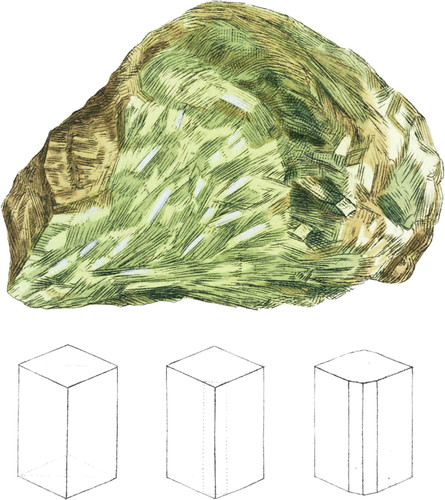 Enlarge
Enlarge
British Mineralogy
Tremolite. Grammatite
- Class 2. Earths.
- Ord. 1. Homogeneous.
- Gen. 4. Silex.
- Spec. . Tremolite.
- Syn.
- Trémolite. Bournon’s Catalogue 87.
- Grammatite. Haüy 3. 227.
- Tremolith. Emmerl. 1. 426.
This specimen is from Scotland. Its harsh, rigid texture, and in some specimens its broad laminae, at first distinguish this substance from varieties of Asbestus and Talc. A certain degree of elasticity distinguishes the fibrous variety from Actinolite, and when crystallized the form of the nucleus, and easy divisibility into fibres by the finger nail, are characters by which it may always be known.
The colour, though generally pale, is however variable; in some parts of the present specimen it passes from white to light greenish and light brown. The lustre is sometimes almost silvery, resembling Mica. In some parts it is in nearly perfect rhomboidal prisms. They show a tendency to the outline below. The cross fracture is fibrous and splintery. The nucleus is a rhomboidal prism of 126° 52′ and 53° 8′, whose terminal planes are perpendicular to the axis. It is divisible also in the direct ton of the two diagonals of its terminal plane. We are indebted to the Count de Bournon for pointing out the distinguishing marks between Tremolite, Actinolite, and Hornblende.

